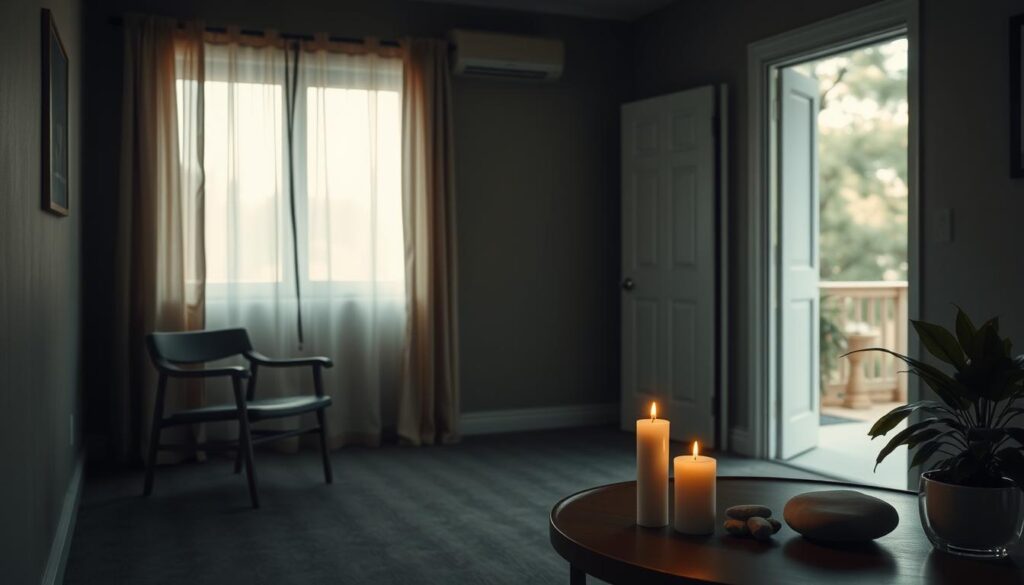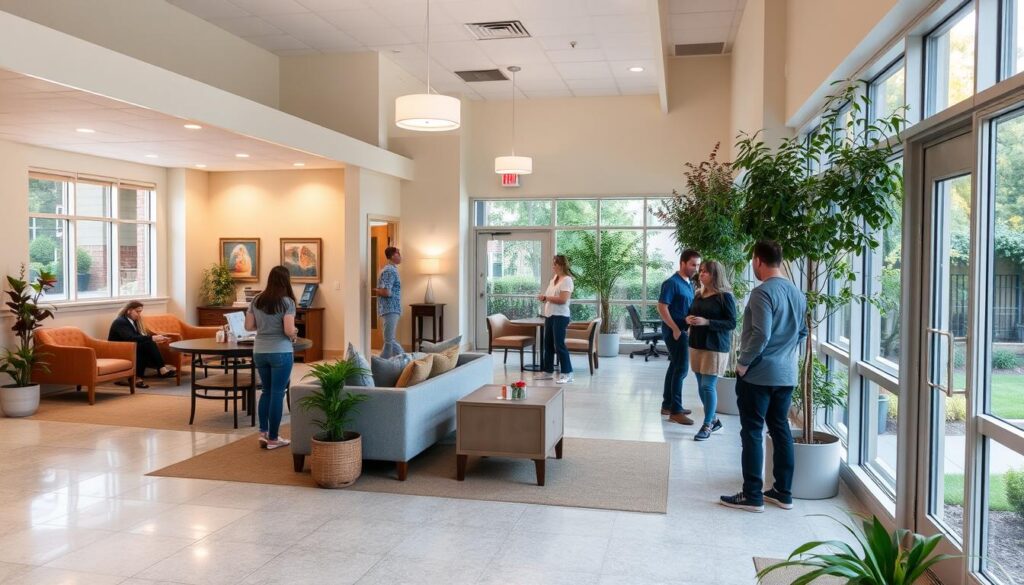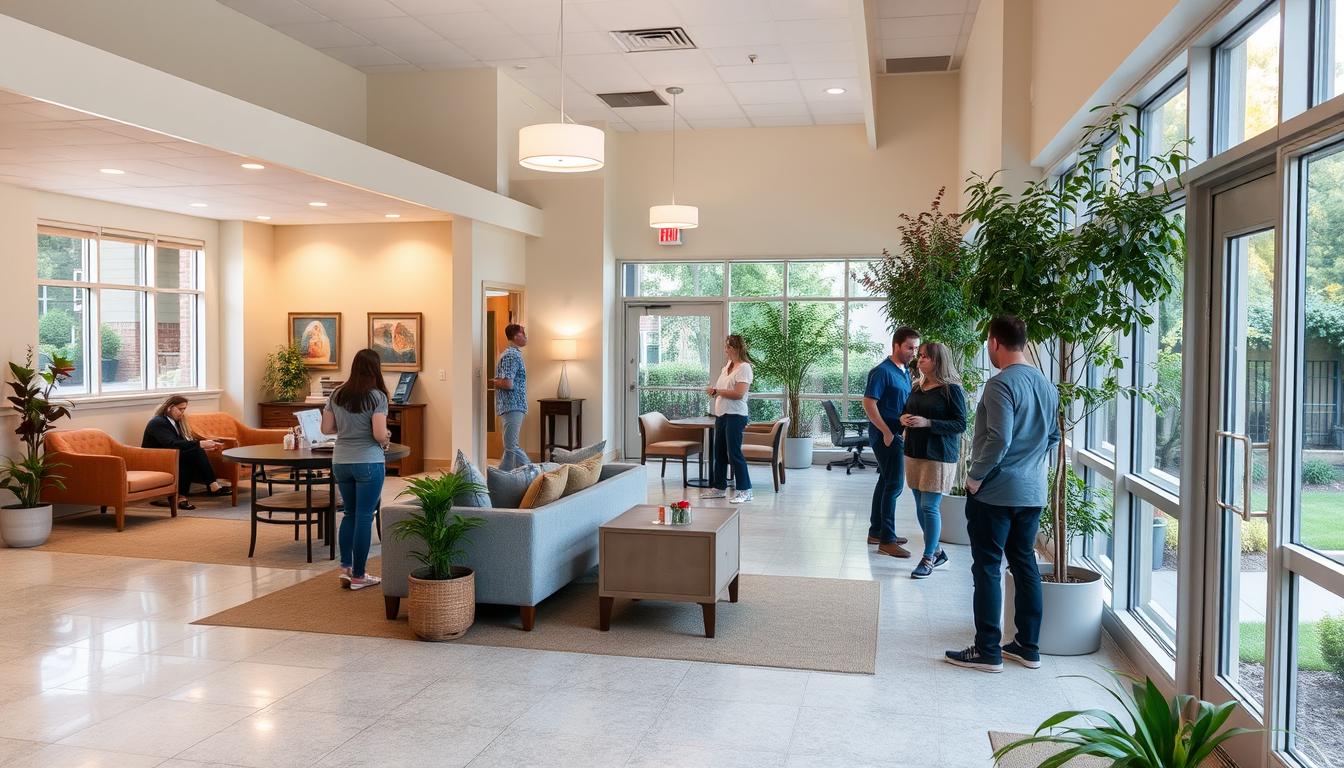Have you ever thought about what goes wrong when mental health care fails in retreat facilities? This is a complex and sensitive topic. It’s important as we look into the reasons behind deaths in these places.
In our growing awareness of mental health, it’s key to understand what leads to these untimely deaths. Knowing these factors helps us see the bigger picture. It also helps us talk about legal issues, safety, staff training, and the emotional impact on families.

Key Takeaways
- The significance of mental health crisis care in retreat behavioral health facilities.
- Understanding common causes of deaths in mental health treatment environments.
- Legal implications surrounding untimely deaths in behavioral health facilities.
- The profound impact on families and loved ones during tragic events.
- Importance of effective protocols and staff training in preventing such tragedies.
Introduction to Behavioral Health Retreats
Behavioral health retreats are special places for people dealing with mental health issues. They offer a healing environment, often called mental health retreats. These centers use many therapies to help each person.
They mix counseling, mindfulness, and fun activities. This helps people heal and get better.
These retreats are different from regular rehab centers. They aim to build supportive communities for growth and emotional balance. Treatment programs cover many mental health problems.
People can relax in a safe space away from daily stress. This helps them focus on healing.
It’s important to know about the risks in these retreats. The relaxed setting might hide some dangers. So, it’s crucial to have safety measures in place.
The Importance of Mental Health Treatment
Mental health treatment is key for people with psychological disorders. It helps them recover and live better lives. It also lowers the chance of suicide. Getting help early is crucial for those in need.
There are many types of mental health treatment. Each one is designed for different needs. Here are a few:
- Psychotherapy: This is talk therapy. It lets people explore their thoughts and feelings in a safe space.
- Medication Management: Psychiatrists can give medicines to help manage symptoms of mental health issues.
- Support Groups: Sharing stories with others who face similar challenges helps people feel connected.
Having access to these services is very important. Especially in places like behavioral health retreats. People get a lot from these programs. They help create places where healing and growth are possible.
Common Causes of Death in Behavioral Health Facilities
Looking into why people die in behavioral health facilities is key. Overdose is a big worry, especially since many patients struggle with substance use. Without enough watch, people can overdose and die without help.
Suicide is another major cause of death. Crisis situations can get out of hand fast for those with severe mental illness. If there’s not enough support, people might try to harm themselves.
Also, health problems play a big role in deaths in these places. Patients might have heart or breathing issues that need quick attention. Without the right care, these problems can lead to sudden death.
It’s vital to have good monitoring and help plans in place. Places that focus on crisis management and train their staff well can lower death rates. Learning from past cases helps make safer places for everyone.
retreat behavioral health death: An Overview
The issue of retreat behavioral health death is a serious concern. Recent incidents show these cases are not just random. They are part of a bigger problem with treatment failures in many places. The overview of retreat behavioral health death shows alarming statistics, pointing out big problems in care.
Many deaths happen because of things that could have been prevented. For example, not watching patients closely enough or not following treatment plans can lead to bad outcomes. These failures can include ignoring medical needs or not dealing with mental health issues well.
Looking at the bigger picture of mental health deaths helps us understand more. Here’s a comparison of general mental health deaths and specific cases from behavioral health retreats:
| Type of Incident | General Mental Health Deaths | Retreat Behavioral Health Deaths |
|---|---|---|
| Accidental Deaths | 45% | 60% |
| Suicides | 30% | 20% |
| Medical Complications | 20% | 25% |
| Other | 5% | 5% |
This table shows why we need better oversight and new rules to prevent more deaths. Knowing about retreat behavioral health death cases helps us understand the need for change. We must make big changes to keep people safe in these places.
Legal Implications of Untimely Deaths
Untimely deaths in behavioral health facilities lead to big legal issues. These issues can affect the whole healthcare system. They often involve questions of who is at fault and if there was negligence.
Understanding these points is key to following healthcare laws. It also helps protect patient safety.
Common Legal Cases Surrounding Deaths
Wrongful death lawsuits often happen after deaths in behavioral health settings. These lawsuits might be because of poor patient care, not enough supervision, or not following rules. These cases can affect many people, including the families of the deceased and the facilities.
Here are some common wrongful death cases:
- Negligent supervision leading to self-harm or accidents
- Inadequate medical treatment or failure to administer prescribed medication
- Failure to provide a safe environment for patients
Impact on Health Care Providers
Wrongful death lawsuits can really hurt healthcare providers. They can lead to higher insurance costs, damage to reputation, and a loss of trust from the community. Healthcare workers may also feel stressed and burnt out from these legal battles.
Knowing the legal implications and following healthcare laws can help. It can reduce risks and make sure patients and staff are safe.
| Type of Case | Potential Outcomes |
|---|---|
| Negligent Supervision | Financial compensation to families, changes in facility policies |
| Inadequate Treatment | Legal fines, revocation of licenses for healthcare providers |
| Unsafe Environment | Increased oversight, mandatory training for staff |
Regulatory Guidelines for Behavioral Health Facilities
Regulatory guidelines are key for keeping patients safe and treatment ethical in behavioral health facilities. They set rules that help facilities follow mental health laws. This protects both patients and those who care for them. Organizations like the Joint Commission and state health departments make these rules.
Facilities must follow strict rules to keep everyone safe. They do this by checking their work often, training staff, and more. This helps them avoid mistakes and improve care. Following these rules can make care better and prevent sad events.
| Regulatory Body | Compliance Requirements | Impact on Safety Standards |
|---|---|---|
| The Joint Commission | Conducts accreditation surveys | Improves patient care through established guidelines |
| State Health Departments | Monitors facility operations and licensing | Ensures facilities meet local safety standards |
| Centers for Medicare & Medicaid Services | Sets conditions for coverage | Promotes high-quality care and accountability |

Case Studies: Notable Retreat Behavioral Health Death Cases
Looking into case studies of behavioral health deaths in retreat settings offers deep insights. Each case shows the complex situations leading to untimely deaths. It reveals patterns that help shape better practices. By studying these events, we can spot the changes needed to avoid future tragedies.
These lessons stress the need for strict care standards. They also highlight the importance of following protocols to protect patients.
Lessons Learned from These Cases
The lessons from notable case studies are key for improvement. Several common themes stand out from these tragedies:
- Communication Failures: Many incidents show poor communication among staff. This can cause misunderstandings and care lapses.
- Lack of Training: Not enough training on crisis intervention and behavioral assessment has led to incidents that got out of hand.
- Poor Protocol Adherence: Some deaths were due to staff not following established protocols. This shows the need for strict guidelines.
- Inadequate Supervision: A common problem is not enough watch over at-risk individuals in treatment facilities.
These case studies give us vital context on behavioral health deaths. They help us take steps to improve safety in our practices or facilities.
Impact on Families and Loved Ones
The loss of a loved one due to behavioral health issues can cause deep emotional pain for families. They often feel a mix of sadness, confusion, and anger. It’s important to understand how these losses affect families and why they need support during this hard time.
Coping with Loss and Grieving
Each family member grieves in their own way. Their personal coping methods, family dynamics, and past experiences with loss play a big role. Recognizing these differences helps families support each other better.
- Emotional Expression: Talking openly about feelings helps create a supportive space.
- Seeking Support: Therapy or support groups can give families the tools they need.
- Memorializing: Creating rituals or memorials honors the loved one and helps everyone grieve together.
It’s key to understand that everyone grieves differently. Families need support that fits their unique situation. This includes counseling, peer support, and information on coping with loss.
| Support Resource | Description | Benefits |
|---|---|---|
| Therapy Services | Individual or family sessions with a psychologist or counselor. | Provides personalized coping strategies and emotional tools. |
| Support Groups | Gatherings of people experiencing similar losses. | Offers community, understanding, and shared experiences. |
| Grief Counseling | Focused counseling on navigating grief and loss. | Helps families process emotions and develop coping strategies. |
Understanding the deep impact on families is crucial. It helps us develop better support systems for those grieving. This way, we can offer more effective help to those left behind.
Improving Safety in Behavioral Health Facilities
Keeping behavioral health facilities safe is key to protecting patients. By setting up strong safety rules, facilities can lower risks in mental health care. Clear guidelines help staff know how to act in emergencies and the value of crisis plans.
Training is essential for safety. Staff should get regular training on spotting danger signs, managing crises, and calming situations. This builds a culture of safety and care, making the place safer for everyone.
Doing thorough risk checks helps find and fix potential dangers. Facilities should check their security often, like their monitoring systems and who can get in. Using these tools helps stop problems before they start, keeping patients safe.

To really improve safety, make a detailed plan of safety steps. Here’s a table showing some strategies and why they’re good:
| Safety Strategy | Benefits |
|---|---|
| Regular Staff Training | Boosts crisis handling skills and teamwork |
| Crisis Intervention Techniques | Less chance of things getting worse |
| Risk Assessments | Finds weak spots and improves safety steps |
| Patient Engagement | Makes patients feel safe and involved |
Putting these steps together creates a strong safety plan. By focusing on safety, facilities not only follow rules but also care deeply for their patients.
Role of Staff Training and Awareness
Staff competency and awareness are key to keeping people safe in behavioral health settings. Training is crucial for staff to handle the challenges they face. It prepares them for emergencies and helps them connect with patients better.
Training for mental health workers teaches them to spot distress signals. It covers emergency responses and how to engage with patients. This education makes care safer and better.
Regular sessions keep staff up-to-date on best practices. This ensures care is always at its highest level. It also helps prevent risks in behavioral health treatment.
| Training Focus Areas | Benefits |
|---|---|
| Recognizing Signs of Distress | Improves early intervention efforts |
| Emergency Response Techniques | Enhances patient safety during crises |
| Therapeutic Engagement Strategies | Strengthens patient-provider relationships |
| Ongoing Education Initiatives | Promotes continuous professional growth |
Good staff training and awareness build a safe and respectful environment. This reduces the chance of tragic events in behavioral health settings.
Preventative Measures to Avoid Tragedies
It’s crucial for behavioral health facilities to have strong safety measures. They must focus on mental health protocols to prevent crises. Regular checks and crisis training can greatly reduce risks in mental health care.
Implementing Effective Protocols
Facilities need to adopt detailed mental health protocols. These should include:
- Regular assessments and monitoring of patients
- Training staff in crisis intervention techniques
- Establishing clear communication channels for emergencies
- Creating individualized treatment plans that consider unique needs
Community and Peer Support
Strong community support is key to safety. Peer support networks help build trust and open communication. They allow people to share their feelings and help each other.
By focusing on community support, facilities can tackle challenges early. This creates a safer place for everyone.
Conclusion
Understanding retreat behavioral health death cases is key to knowing more about mental health facilities. This knowledge helps us see how these incidents affect patient safety and treatment success. It also shows the importance of mental health awareness and legal actions after such events.
To create a safe place for recovery, we all need to work together. This means setting up stricter rules and supporting each other in the community. Every effort we make can help lower the number of deaths in these facilities.
The work to improve these systems never stops. We must keep pushing for better care and watch over safety standards. By doing this, we help make sure everyone gets the care they need. This can save lives and help people recover fully.
FAQ
What are the primary causes of death in behavioral health facilities?
Deaths often result from overdose, suicide, and medical issues. Poor monitoring in crisis situations also plays a role.
How can families cope with the loss of a loved one in a retreat behavioral health setting?
Families can find support through counseling, groups, and mental health resources. These help them cope and find peace.
What legal measures can families take following an untimely death in a behavioral health facility?
Families might consider wrongful death lawsuits. It’s wise to talk to legal experts to understand their rights and options.
How are behavioral health retreats different from traditional rehabilitation centers?
Retreats focus on holistic healing and use alternative therapies. They offer a less clinical setting. Traditional centers often focus more on medical treatments.
What regulatory guidelines must behavioral health facilities comply with?
Facilities must follow rules from the Joint Commission and state health departments. These ensure safety and ethical care.
What preventative measures can be implemented to reduce risks in behavioral health retreats?
To reduce risks, retreats can use regular assessments and crisis intervention. They should also train staff well.
Why is staff training important in preventing deaths in behavioral health settings?
Training helps staff recognize distress and respond in emergencies. It also helps them engage with patients, making the setting safer.
What impact do retreat behavioral health deaths have on communities?
These deaths raise awareness about mental health treatment. They show the need for better resources, leading to stronger community support.


